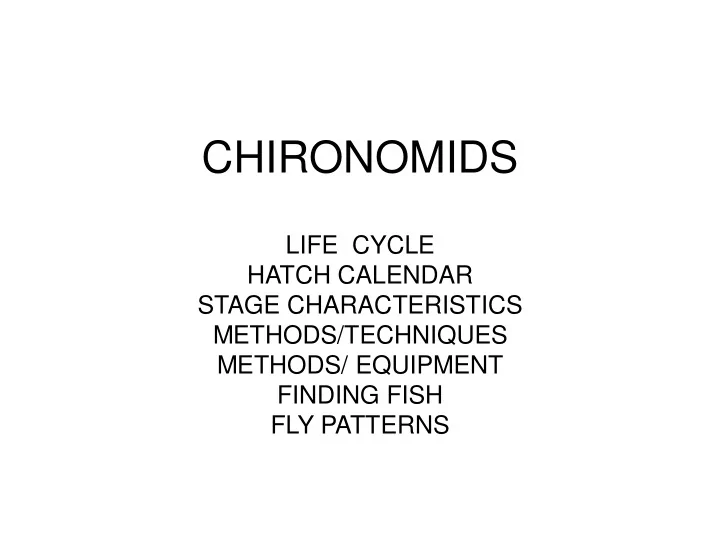

CHIRONOMIDS LIFE CYCLE HATCH CALENDAR STAGE CHARACTERISTICS METHODS/TECHNIQUES METHODS/ EQUIPMENT FINDING FISH FLY PATTERNS
LIFE CYCLE The chironomid has three (3) distinctly different, and all fishable , stages of life; (1) the larva (aka ... the bloodworm), (2) the pupa (which in our opinion is the most important as far as fly fishing is concerned), and (3) probably the least concerning to fly fishers yet important enough to understand, the mosquito like mature adult (winged terrestrial).
LIFE CYCLE
HATCH CALENDAR MINOR HATCHES LARVA MAJOR DOLDRUM LARVA MIGRATION HATCHES THERMOCLINE MIGRATION PUPA
LARVA STAGE
PUPA STAGE It is often thought by anglers that Chironomid pupae migrate directly from their mud tubes to the surface to hatch. However, Brian Chan (a well-known fisheries biologist from British Columbia and Chironomid fishing expert) has documented another aspect of this insect's life style that explains why fishing these imitations deep works so well. He took a team and an underwater camera to one of his area lakes to videotape migrating pupae. What he found is that after leaving their mud tube, the pupae swirl around in the water one to two feet off the bottom of the lake bed. During this process, they mature (stage) for three to five days before they make their journey to the surface to hatch as adults. This explains why the first one to two feet off the lake bottom is often so productive, and also why trout often take Chironomid pupa imitations deep in the lake when there is no evidence of a hatch on the surface.
Chironomid Methods 1. Indicator 2. Long line or Naked 3. Wind drifting 4. Dangling 5. Slow sink or Hover 6. Dry/Emerger
Double Anchor
INDICATOR INDICATOR
LONG LINE OR NAKED OR LONG NAKED LINING
Wind Drifting
DANGLING
SLOW SINK OR HOVER
FINDING FISH HATCH – FIND MOVE!!! BIRDS, SEASON FISH BRIAN/OTHER ADULTS, MOVING FISHERMEN SHUCKS BATHMETRIC MAPS
2012 4’ TO 5’ 2010 11’ TO 12” 2008 10’ TO 11’ 2009 18’ TO 22’ 2011 18’ to 22 ’ 2013 5’ to 8’ 2014 8 ’ to 10 ’ 2015 5’ to 8’
THERMOCLINE – 30’ TO 35’
EDGES DROP OFFS WEED BEDS
Equipment • Fly rod -4,5,or 6wt. Stiff butt flexible tip (Switch R od – RIO short shooting head) • Reel - Wide arbor • Line – Appropriate to method. Rio or SA Indicator Line, Midge Tip, Hover, Type 4,5 or 6 full sink, WF Floating, Neutral Density, at least 50yds of backing. • Throat Pump. • Specialty leaders for indicator and naked methods. • Sounder. • Rod Holder. • Break Away Indicator. • Bobber Stopper. • Fluorocarbon Tippet 3, 4 and 5x. 3 and 4x, 12 foot mono leaders. • Lead weight or forceps
Use an indicator you can see
Sounder
Indicators and Bobber Stoppers
Poor Man’s Depth Sounder
Throat Pump
Specialty Leaders Long Line/Naked Leader Standard 9 foot tapered leader cut back 2 ½ feet Add 10-15 feet of 8 pound Maxima Ultragreen Add swivel Add 4x fluorocarbon as needed to achieve 125% of water depth Indicator Leader 10 -15 feet of non stretch braid or 17 pound fluorocarbon with perfection loop, Thill Indicator or breakaway indicator, #10 swivel, and 4x fluorocarbon tippet as needed
Fly Patterns
Fly Pattern Sizes and Colors Chironomid pupa and adults tend to be larger as you move farther north and smaller as the season progresses towards fall. Chironomid pupa tend to fall into the following range of sizes WA, ID,MT and OR 10,12,14,16,18,20 Canada 8, 10,12,14,16,18 Chironomid adults are typically one size smaller than the pupa Chironomid colors range from black (most common) to silver, dull silver, red, olive, tan, copper or brown and chartreuse. Use your throat pump to sample the naturals the fish are eating so as to select the appropriate size and color.
Brown and Copper
Duller Chromie
Antistatic Chromie
Chromie
Red and Black
Black Sno-cone
Black Buzzer
Olive and Copper
Bloodworm
Bloodworm Cluster
Lady Mc Connell
Rubber Legs Midge
Stuck in the Shuck
Hiviz Adult
Midge Emerger
Watercraft 1. Fish from shore • Economical, good visibility, limited mobility and access, quiet 2. Step Ladder • Better visibility, limited mobility and access, easy transport, quiet 3. Float Tube/U Boat • Cold, slow, fair visibility, fair mobility, sounder friendly, easy transport, quiet, $ 4. Pontoon Boat • More comfortable, good visibility, some storage for rods and gear, good mobility, electric motor possible, sounder friendly, car topable, quiet, $$ 5. Pram • Warm and comfortable, room for rods and gear, excellent mobility, excellent visibility (standing), electric or outboard motor possible, sounder friendly, car top or trailer. double anchor, quiet, fish two rods, $$ 6. Car Topper/Trailered Boat • Same as pram, noisy if aluminum (carpet the bilge), $$$ 7. Drift boat/Skiff • Same as pram, may not have double anchor, wind target, $$$$
Rod Holder
Trailer
Skiff/Car Topper
Skiff/Car Topper
Bow Anchor
Recommend
More recommend